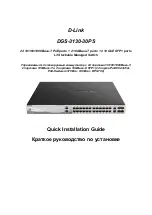
82
Advanced Settings
SNMP agent: Software which runs on managed devices for maintaining management
information base and reporting management data to a SNMP management system
when it is needed.
MIB: A management information base (MIB) is a database used for managing the
entities in a communications network. It defines a series of properties for those
managed entities: object name, access right, data type, etc. every SNMP has its
corresponding MIB and the SNMP manager can perform read/write action
accordingly.
SNMP agent is managed by SNMP manager and they two interact with each other via
SNMP protocol.
SNMP Actions
The following three basic actions are available on this switch to execute
intercommunication between the SNMP manager and SNMP agent:
Get request: A manager-to-agent request to retrieve the value of a variable or list of
variables.
Set request: A manager-to-agent request to change the value of a variable or list of
variables in MIB.
Trap: Asynchronous notification from agent to manager. SNMP traps enable an agent
to notify the management station of significant events (such as reboot the managed
device) by way of an unsolicited SNMP message.
SNMP Protocol Versions
Only SNMP manager and SNMP agent share the same SNMP version configurations can
they access each other successfully. So far, this switch supports SNMPv3 and is
compatible with SNMPv1 and SNMPv2c.
SNMPv1: The community name is used to define the relation between SNMP
Manager and SNMP Agent. The SNMP packets failing to pass community name
authentication are discarded. The community name can limit access to SNMP Agent
from SNMP NMS, functioning as a password.
SNMPv2c: SNMP v2c also adopts community name authentication. It is compatible
with SNMP v1 while enlarges the function of SNMP v1: provide more action types
(GetBulk and InformRequest); support more statistics types (like Count64); provide
more error codes for distinguishing errors.
SNMPv3: Based on SNMP v1 and SNMP v2c, SNMP v3 extremely enhances the
security and manageability. It adopts VACM (View-based Access Control Model) and
USM (User-Based Security Model) authentication. The user can configure the
authentication and the encryption functions. The authentication function is to limit the
Содержание G3210P
Страница 1: ......
Страница 6: ...Product Overview Package Contents Physical Appearance...
Страница 127: ...122 Advanced Settings 2 Click Save on the pop out dialog 3 Select a path to save files to your local PC and click Save...
Страница 129: ...Appendix Technical Specifications Default Settings Safety and Emission Statement...
















































